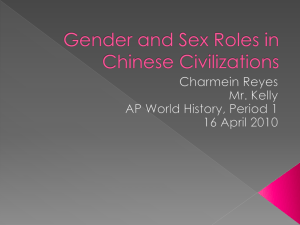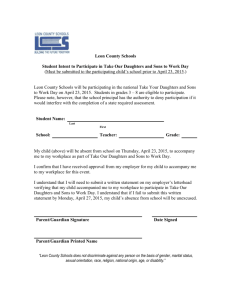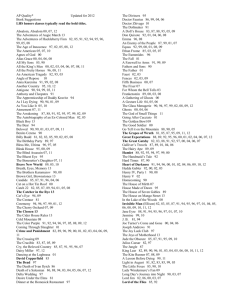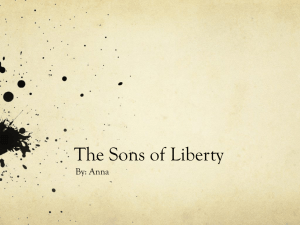GENESIS CHAPTER 10 OUTLINE I. The sons of Noah vs 1 II
advertisement
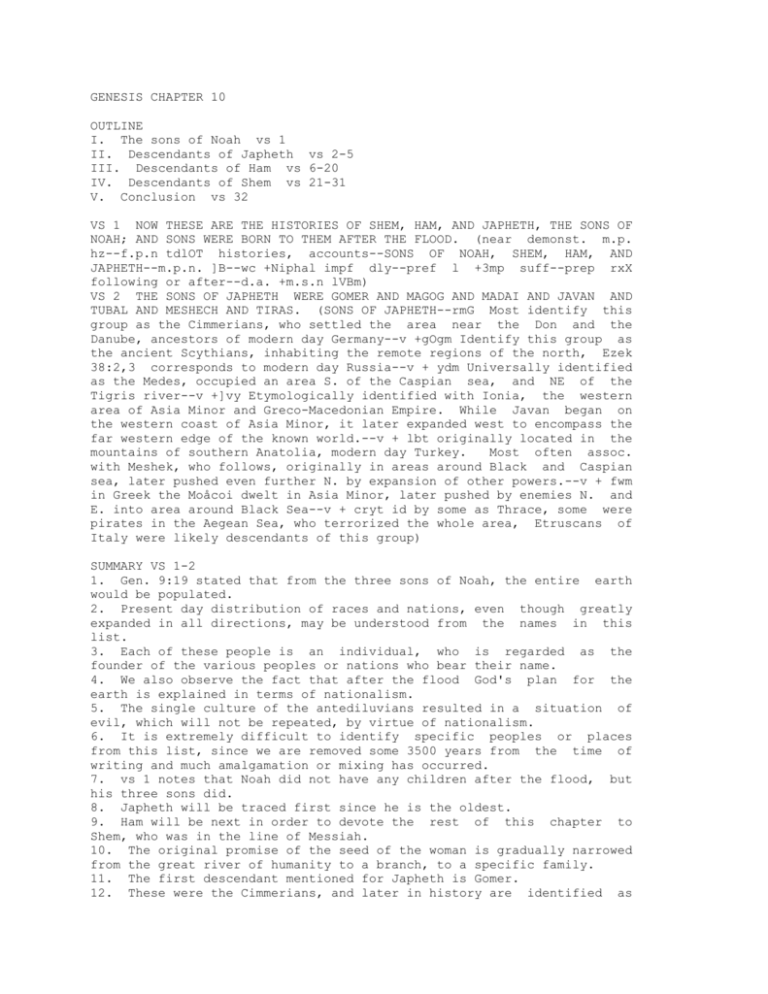
GENESIS CHAPTER 10 OUTLINE I. The sons of Noah vs 1 II. Descendants of Japheth vs 2-5 III. Descendants of Ham vs 6-20 IV. Descendants of Shem vs 21-31 V. Conclusion vs 32 VS 1 NOW THESE ARE THE HISTORIES OF SHEM, HAM, AND JAPHETH, THE SONS OF NOAH; AND SONS WERE BORN TO THEM AFTER THE FLOOD. (near demonst. m.p. hz--f.p.n tdlOT histories, accounts--SONS OF NOAH, SHEM, HAM, AND JAPHETH--m.p.n. ]B--wc +Niphal impf dly--pref l +3mp suff--prep rxX following or after--d.a. +m.s.n lVBm) VS 2 THE SONS OF JAPHETH WERE GOMER AND MAGOG AND MADAI AND JAVAN AND TUBAL AND MESHECH AND TIRAS. (SONS OF JAPHETH--rmG Most identify this group as the Cimmerians, who settled the area near the Don and the Danube, ancestors of modern day Germany--v +gOgm Identify this group as the ancient Scythians, inhabiting the remote regions of the north, Ezek 38:2,3 corresponds to modern day Russia--v + ydm Universally identified as the Medes, occupied an area S. of the Caspian sea, and NE of the Tigris river--v +]vy Etymologically identified with Ionia, the western area of Asia Minor and Greco-Macedonian Empire. While Javan began on the western coast of Asia Minor, it later expanded west to encompass the far western edge of the known world.--v + lbt originally located in the mountains of southern Anatolia, modern day Turkey. Most often assoc. with Meshek, who follows, originally in areas around Black and Caspian sea, later pushed even further N. by expansion of other powers.--v + fwm in Greek the Moåcoi dwelt in Asia Minor, later pushed by enemies N. and E. into area around Black Sea--v + cryt id by some as Thrace, some were pirates in the Aegean Sea, who terrorized the whole area, Etruscans of Italy were likely descendants of this group) SUMMARY VS 1-2 1. Gen. 9:19 stated that from the three sons of Noah, the entire earth would be populated. 2. Present day distribution of races and nations, even though greatly expanded in all directions, may be understood from the names in this list. 3. Each of these people is an individual, who is regarded as the founder of the various peoples or nations who bear their name. 4. We also observe the fact that after the flood God's plan for the earth is explained in terms of nationalism. 5. The single culture of the antediluvians resulted in a situation of evil, which will not be repeated, by virtue of nationalism. 6. It is extremely difficult to identify specific peoples or places from this list, since we are removed some 3500 years from the time of writing and much amalgamation or mixing has occurred. 7. vs 1 notes that Noah did not have any children after the flood, but his three sons did. 8. Japheth will be traced first since he is the oldest. 9. Ham will be next in order to devote the rest of this chapter to Shem, who was in the line of Messiah. 10. The original promise of the seed of the woman is gradually narrowed from the great river of humanity to a branch, to a specific family. 11. The first descendant mentioned for Japheth is Gomer. 12. These were the Cimmerians, and later in history are identified as modern Germanic peoples. 13. The second son is Magog, the ancient Sythians, and later occupy modern Russia. 14. The third son is Madai, who are identified with the ancient Medes. 15. The fourth is Javan, who is the ancestor of the Ionians and Greeks. 16. The fifth is Tubal, the ancient Tibarenians, pushed later into modern Turkey or southern Russia. 17. The sixth is Meshek, the ancient Moschoi, pushed later into Russia. 18. The last is Tiras, a group of marauding pirates who populated the area around the Aegean sea. 19. While these men and their descendants occupied areas in and around Asia Minor, territorial expansion to the north and west resulted in them finally occupying vast amounts of space. 20. This is the historical fulfillment of what Noah referred to in 9:27. VS 3 AND THE SONS OF GOMER WERE ASHKENAZ AND RIPHATH AND TOGARMAH. (SONS OF GOMER--znKwX Jewish tradition to this very day identifies this group with Germany, their original position seemed to be in the mountains west of the Caspian sea. Descendants are identified as Goths, Vandals, Franks, Saxons, Angles, etc.--v +tpyr Josephus ids them in the region of Paphlagonia, S. of the Black sea, others suggest descendants include the Celts, Brithons, Irish, etc.--v + hmrgt SW Armenia, still known as Thorgom, Turkey and SW Russia) VS 4 AND THE SONS OF JAVAN WERE ELISHAH AND TARSHISH, KITTIM AND DODANIM. (SONS OF JAVAN--hwylX these 4 which follow were descendants of the Greeks, and represent the most southerly and westerly peoples on the Mediterranean. Elishah supplied purple dye to Tyre, inhabited the coast lands on the Aegean--v +wywrt Area in southern Spain--,yTK lit. Kits, connected with Cyprus--v +,yndd due to similarity between Heb. r and d, most identify this group as Rodanim, or Rhodians) VS 5 FROM THESE THE COAST LANDS OF THE NATIONS WERE SEPARATED INTO THEIR LANDS (pref. m +demons m.p. hLX "these"=vs 2-4--m.p.n.const yX habitable land, whether inland, coast land, or island--d.a. +m.p.n yOG-Niphal pf drP to break off or break in pieces, in pass. to be broken, divided or separated--pref b +'erets +3mp suff) EVERYONE ACCORDING TO HIS LANGUAGE, ACCORDING TO THEIR FAMILIES, INTO THEIR NATIONS (m.s.n wyX pref l +m.s.n ]Owl a tongue, hence a language or dialect--pref l + f.p.n hxPwm a circle of relatives with strong blood ties, families tend to stick together since blood relationships tend to promote greater loyalty and trust, etc.--pref b +m.p.n +3mp suff yOG) SUMMARY VS 3-5 1. Moses picks the most important of the sons of Japheth and gives us further information as to their family tree. 2. Initially all these people settled somewhat further away from the organized population, but did not immediately inhabit the lands which would later become theirs. 3. It is somewhat difficult, if not in certain cases impossible to fix the descendants of each of these men. 4. It is obvious that they were important figures in their time, and that they figured prominently in the course of history. 5. The first of the sons of Gomer was Ashkenaz, who the Jews identify as the modern Germans, and others suggest that their descendants include the Goths, Vandals, Franks, Saxons, etc. 6. The second son of Gomer is Riphath, and it is suggested that they occupied an area S. of the Black Sea, and later emerged as the Celts, British, Irish, etc. 7. The third son is Togarmah, who is most clearly linked to the area in Armenia, and SW Russia, and modern Turkey. 8. The sons of Javan, who was the forerunner of the Greek peoples, were 4 in number. 9. Elishah is linked to the Greek culture in the coast lands on the W. of Greece, including Italy, Sicily, and N. Africa. 10. Tarshish is most generally agreed to inhabit the region of southern Spain, farthest away from the initial population after the flood. 11. The Kittim, or people of Kit, are connected to the regions around modern Cyprus. 12. The Dodanim, or Rodanim, are somewhat obscure, but may have occupied the area around the isle of Rhodes. 13. What is specifically stated by Moses in vs 5 is that these are the people from whom the nations eventually descended. 14. This forms the beginning of the new regime for the human race after the flood, and that is DI #4, nationalism. 15. It is evident from the Word of God that mankind came from a common stock, and was scattered over the face of the earth. 16. The two primary criteria which determined which groups ended up in which geographic locales are now stated. a. Language, dialect, etc. b. Family ties 17. Blood relationships and common language are the single two most important factors in establishing a nation. 18. The descendants of Japheth occupy the largest territory, and generally inhabit the region from Spain to Media, and the massive amount of land north of that line will be theirs. VS 6 AND THE SONS OF HAM WERE CUSH AND MIZRAIM AND PUT AND CANAAN. (SONS OF HAM--wVK name means black, no reason not to assume that this refers to the pigmentation of his skin, and if he was indeed the first black man, likely inspired a certain amount of respect and/or fear. His descendants would later occupy the area of western Arabia and Eastern Africa, below Egypt. A land bridge??--v +,yrjm this word is a dual, most acknowledge freely that it is Egypt, and dual for upper and lower Egypt--v +uVp identified with Lybia in northern Africa, and extended south to occupy area W. of Cush--v + ]ink original settlers of Palestine VS 7 AND THE SONS OF CUSH WERE SEBA AND HAVILAH AND SABTAH AND RAAMAH AND SABTECA; AND THE SONS OF RAAMAH WERE SHEBA AND DEDAN. (SONS OF CUSH --Xbc occupied S. Arabia, and were later known as the Sabeans, Job 1:15 --v +hlyvx name means sand land, occupied area of central Arabia--v + hTbc area of S. Arabia--v + hmir area of SE Arabia in region of Oman--v +XkTbc SE Arabia is the best guess--SONS OF RAAMAH--Xbw SW Arabia, now modern Yemen--v + ]dd West central Arabia, famous for its commercial activity) SUMMARY VS 6-7 1. Ham is the next son of Noah whose descendants are detailed for us by Moses. 2. The Hamitic peoples were the first great empire builders, as we will shortly observe. 3. In general the four sons of Ham mentioned in vs 6 occupied the land in N. and E. Africa, the area of the Arabian peninsula, and extended north into Palestine. 4. The men and their modern day counterparts: A. Cush, first black man occupies Ethiopia and w. Arabia B. Mizraim refers to Egypt and the two divisions, upper and lower C. Phut occupied an area E of Egypt and Ethopia, and =Libya D. Canaan occupied Israel but was dispossessed during the conquest. 5. The sons of Cush in vs 7 generally settled the Arabian peninsula, each one occupying his own specific part. VS 8 NOW CUSH BECAME THE FATHER OF NIMROD; HE BECAME A MIGHTY ONE ON THE EARTH. (v + Cush--Qal pf dly to bring forth, to beget--s.d.o + drmn the name is either derived from marad, to rebel or incite to sedition, hence to be rebel, or a compound of leopard and subdue, hence the subduer of the leopard. The word for leopard is not found in any writing in the OT earlier than around the time of Solomon, and being a rebel fits perfectly the character of Nimrod, perhaps both are in view. --pers pron. XVh--Hiph pf 3ms llx to begin or originate someth. To cause to open, Gen. 4:26--pref l +Qal inf const hyh--m.s.adj rOBG mighty, strong, warlike, used before only of the very evil angel-men-pref. b + d.a. +'erets) VS 9 HE WAS A MIGHTY HUNTER OPENLY, BEFORE THE LORD; (pers. pron + Qal pf hyh "he himself became"--adj.m.s. const rOBG +m.s.n dyj a hunter one who lies in wait to take prey--pref l +faces of YHWH. The use of YHWH here indicates that his hunting was not only physical, but had some sort of spiritual connotation. As we will see, he was revered by those on the earth and used his power and position to subvert the Plan of God.) DUE TO THIS IT IS STILL SAID, "LIKE NIMROD, A MIGHTY HUNTER BEFORE THE LORD (]K=li =upon thus, therefore--Niphal impf rmX it is said, with the sense that this was a proverb in Moses day, some centuries later--LIKE NIMROD, MIGHTY OF HUNT BEFORE THE LORD) VS 10 AND THE BEGINNING OF HIS KINGDOM WAS BABEL AND ERECH AND ACCAD AND CALHEH, IN THE LAND OF SHINAR. (wc +Qal impf hyh f.s.n const. tywXr beginning or first point--f.s.n hklmm kingdom or dominion, area of reign --lbB The earliest of post diluvian cities, This chapter contains info, which is antedated by some of chapter 11. the name Babel is in the Sumerian, Akkadian, and Babylonian= gate of God. In the Hebrew =confusion. Was the earliest post diluvian city--v +frX known to the Sumerians as Unu and to Akkadians as Uruk, listed in Sumerian king list as the seat of the 2nd dynasty after the flood--v + dKX Sumerian city = Agade, first great dynasty was under one Sargon, whose name =true king --v + hnlk no one has identified this one yet.--pref b +'erets =in the region or area of--rinw Used to describe the region which included the cities above, identified as the ancient Sumer, non-Semitic people and language. The cradle of civilization, located between the Tigris and Euphrates rivers. In all the Sumerian king lists, the tenth generation is the one who endures and survives the flood. This must be dated in light of the revised chronology, and the earliest dynasty around 2500 BC VS 11 FROM THAT LAND HE WENT FORTH INTO ASSYRIA, AND BUILT NINEVEH AND REHOBOTH-IR AND CALAH, (FROM THE LAND, THE THAT= Shinar--Qal pf Xjy he went out, or departed--rVWX Assyria--wc +Qal impf hnB--s.d.o +hvnyn famous city of antiquity, located along the Tigris. the Assyrian name was Ninua, a name of the Goddess Ishtar, and indicates that the city was certainly linked with an early false religion.--v +s.d.o +ryi=tbxr lit. =broad places of a city, Rebit-Ninua a suburb of Ninevah, on the west--v +s.d.o +xlK located some 24 miles away, known as Kalchu) VS 12 AND RESEN BETWEEN NINEVEH AND CALAH; THAT IS THE GREAT CITY. (v + s.d.o + ]cr another suburb of Nineveh--BETWEEN NINEVEH AND BETWEEN CALAH--remote demons.f.s. "that"=Nineveh--the city the great) SUMMARY VS 8-12 1. The most famous or infamous son of Cush is noted in vs 8. 2. During the life of Nimrod he so made his mark on the culture, that he began to be a mighty one in the region of Shinar. 3. As we will observe, he was not content to tyrannize one particular region, he had designs on expanding his empire. 4. The term "mighty one" has been used to this point to refer to the offspring of the angelic infiltration. 5. This indicates that during his lifetime, Nimrod's fame and power achieved legendary proportions. 6. His name is likely derived from Marad, to rebel and indicates the nature of his lifestyle. 7. It is possible that he first achieved fame and power due to his physical exploits over the animal kingdom. 8. After the flood, animals possessed a ferocity which they did not possess previously. 9. Some state that he "hunted down and ridded the world of monsters, and so gained for himself the character of a great benefactor to the human race." 10. Many commentators suggest that this hunting was in regard to human prey and his desire was to conquer and enslave the human race for his own purposes. 11. In either case his physical prowess and desire to rule resulted in the cosmos exalting him to legendary status, and in Nimrod becoming the first despot or tyrant. 12. While there is nothing wrong with hunting and subduing animals, from this arose the notion of subduing mankind. 13. In the physical realm, the cosmos applauds and worships the concepts of physical prowess, thus elevating the one who possesses these qualities to celebrity status. 14. The cosmos is however, quick to forget and will be impressed even more with one who can outdo the previous mighty man. 15. Therefore, once elevated to the status of celebrity one must continue to find ways to maintain the allegiance of those whom he desires to rule. 16. Since men are for the most part negative to God and His plan, a system of religion in opposition to God and His plan, would achieve a large following in a short time. 17. If this religion is geared to the worship of the celebrity and his family, they can be assured of continual allegiance. 18. This is precisely what Nimrod did, and he, his father and his wife may be traced in the ancient religions of Babylon and Nineveh. 19. As a matter of fact, since their system was observable in the attempt to build the tower into heaven, we may find it in the many cultures of the world, after the dispersion. 20. From the statement in vs 10 and the fact that it is not stated that Nimrod built Babel, it is observed in a careful study of the origin of Babylon that Cush was the ringleader in the tower. 21. Aside from his physical prowess which men came to rely on, he advocated a way to heaven, and men quickly fell in with the plan. 22. A four city metropolis was the beginning of his attempt at world domination. 23. Babel, which means "the gate of God", Erech, known also as Uruk in the Sumerian history, Accad, also known as Agade, and Calneh, which has yet to be clearly identified. 24. All this dynasty was to be found in the land of Shinar, which is located in the area NW of the Persian gulf. Ancient Sumer 25. This was the first region to be heavily inhabited as mankind expanded and journeyed away from the regions of Ararat. 26. For some reason, Nimrod left off his empire building attempt and relocated to the region of Assyria, further NW of Shinar. 27. The reason is found in Genesis 11 and the confusion of the languages by God. 28. Again he built a large metropolis, which consisted of several key cities, which formed a loose sort of city-state. 29. They included Nineveh, Rehoboth-Ir, Calah and Resen. 30. We hear no further of Nimrod, but he may be traced in Assyrian history, and is known as Ninus. VS 13 AND MIZRAIM BECAME THE FATHER OF LUDIM AND ANAMIM AND LEHABIM AND NAPHTUHIM. (MIZRAIM=Egypt--Qal pf dly--s.d.o +,ydVl Lybians of area W. of Egypt--v +s.d.o +,ymni an obscure African tribe, all these sprang from the Egyptians and are scarcely identifiable, although they were certainly important in their time--v +s.d.o + ,ibhl possibly Libyans-- v +s.d.o + ,yxTpn resided around Memphis, near delta) VS 14 AND PATHRUSIM AND CASLUHIM (FROM WHICH CAME THE PHILISTINES) AND CAPHTORIM (v +s.d.o + ,ycrtP south or upper Egypt, near Ethiopia--v + s.d.o + ,yxlcK obviously the forefathers of the Philistines--v +s.d.o + ,yrTpK Amos 9:7 states that God brought the Philistines from Caphtor, not that they were necessarily descended from the Caphtorim) SUMMARY VS 13-14 1. Mizraim who was the ancestor of the Egyptians, known in Egyptian history as Menes or Mestraim. 2. These two verses deal with those who descended from him, and generally deals with groups which inhabited the area around Egypt. 3. Some of these groups cannot be identified with complete accuracy today, but were of some importance in the ancient world. 4. One specific group which was quite visible in Moses' day, and who are mentioned often in the WOG are the Philistines. 5. While they are Hamitic in origin, coming from a group known as the Casluhim, they eventually migrated from an area known as Caphtor. 6. This is recognized to be the island of Crete. VS 15 AND CANAAN BECAME THE FATHER OF SIDON, HIS FIRST-BORN, AND HETH (CANAAN--Qal pf dly--s.d.o + Sidon, his first born rOkb first born, whether of man or animals--s.d.o + Heth VS 16 AND THE JEBUSITE AND THE AMORITE AND THE GIRGASHITE VS 17 AND THE HIVITE AND THE ARKITE AND THE SINITE VS 18 AND THE ARVADITE AND THE ZEMARITE AND THE HAMATHITE; AND AFTERWARD THE FAMILIES OF THE CANAANITE WERE SPREAD ABROAD. VS 19 AND THE TERRITORY OF THE CANAANITE EXTENDED FROM SIDON AS YOU GO TOWARD GERAR, AS FAR AS GAZA; AS YOU GO TOWARD SODOM AND GOMORRAH AND ADMAH AND ZEBOIIM, AS FAR AS LASHA (this geographical note gives us the area which was generally occupied by the Canaanites, Sidon was the northern most major area, they extended southward along the Medit. to the area of Gaza. In the east and south to the cities along the southern end of the Dead Sea, eastward to an area known as Lasha in the region of Moab) VS 20 THESE ARE THE SONS OF HAM, ACCORDING TO THEIR FAMILIES, ACCORDING TO THEIR LANGUAGES, BY THEIR LANDS, BY THEIR NATIONS. SUMMARY VS 15-20 1. The final son of Ham and his descendants are now detailed. 2. Since Canaan is under the curse of 9:25, his offspring are cursed by association. 3. This does not preclude positive volition, SAJG, or any of the adjustments to any descendant of Canaan. 4. The curse merely stated that as a rule all these peoples who descended from Canaan would be slaves to the descendants of Shem and Japheth, and also to his own brothers. 5. Once again it is evident that positive volition may surface in any race, geographical area, etc. 6. Arrogance based on race, geography, language, etc. is foolish. 7. On the other hand, we do not assume that every Canaanite will be positive, on the contrary most are negative, and come under temporal and eternal judgment. 8. The fact is, in terms of positive volition, you wait and see, and people must demonstrate themselves to be positive. 9. vs 15 mentions two specific sons of Canaan, his first born Sidon, and Heth. 10. Sidon was the ancestor of the Sidonians, or Phoenicians, who occupied the area with such cities as Tyre and Sidon. 11. Heth was the ancestor of the Hittites, who lived in Canaan, until the last mention of them in the time of Solomon. IIChron. 8:7ff 12. There is a change in the format of listing these descendants, which is used since we are no longer dealing with direct sons, but groups of people who descended from Canaan. 13. Jebus is the Canaanite name for the city of Jerusalem, the place of the Jebusite. 14. The Amorites occupied an area N. or the Arnon R. S. of the Jabbok R., E. of the river Jordan. Assyrians called them Amurri 15. The Girgashites have not been clearly identified or located. 16. The Hivites occupied the area E. of Sidon, in the region of Lebanon in the vicinity of Mt. Hermon. 17. The Arkites were people who inhabited the town of Arka N. or Sidon. 18. Sin, a city in N. Phoenicia, is called a city on the coast and was the region of the Sinites. 19. Arvad was the northernmost city in Phoenicia and home to the Arvadite. 20. The Zemarite occupied an area in N. Phoenicia, likely the modern city of Sumra. 21. The Hamathites were somewhat NE of Phoenicia, located in the town of Hamath, on the Orontes river. 22. The geographical note in vs 19 does not give the limits of the Canaanites, but the regions which were generally considered to belong to them. 23. Vs 20 is similar to vs 5 and states that certain factors determined the ultimate placement of each of these nations. 24. Family ties and language were certainly the most crucial in determining who would reside where. 25. Often it is noted that either the residents gave their name to a specific city, as in the case of the Jebusites, or derived their name from a city, as in the case of the Hamathites. VS 21 AND ALSO TO SHEM, THE FATHER OF ALL THE CHILDREN OF EBER, AND THE BROTHER OF JAPHETH, THE OLDER, CHILDREN WERE BORN. (Pual pf dly Pual indicates that a midwife or someone else aided in the birth--adv ,G a+ pers. pron. XVh indeed he is--bX father here is clearly used for ancestor, not linear father--ALL THE SONS OF EBER--m.s.n.const xX-Japheth--d.s. + adj.m.s lOdG VS 22 THE SONS OF SHEM WERE ELAM AND ASSHUR AND ARPACHSHAD AND LUD AND ARAM. VS 23 AND THE SONS OF ARAM WERE UZ AND HUL AND GETHER AND MASH. VS 24 AND ARPACHSHAD BECAME THE FATHER OF SHELAH; AND SHELAH BECAME FATHER OF EBER. THE SUMMARY VS 21-24 1. Having dealt with the less significant of the sons of Noah in terms of the Plan of God, Moses now proceeds to trace the line of the seed of the woman. 2. Shem is specifically noted as the father of the children of Eber, who is singled out as being quite important. 3. As it turns out, Eber fathered two significant branches of descendants, those culminating in Abraham, and the Arabian families. 4. Moses will trace this line to the Arabian side first, since they are not nearly as important to God's plan as Abraham, who will be traced in Chap. 11 5. While the Arabians and Abraham ultimately proceeded from the same genetic stock, spiritually they are quite different. 6. vs 21 specifically notes that Japheth was the oldest of the three sons of Noah. 7. The first son mentioned is Elam, who became the father of the Elamites, who occupied an area E. of the Tigris. 8. The second is Asshur, and refers to the ancestor of the Assyrians, located around the capital and chief city Nineveh. 9. Arpachshad, was the son who was qualified as primogeniture, and the source of spiritual blessing and leadership to his generation. 10. Ultimately after a period of nomadic life, they settled in a region of Ur of the Chaldees. His name means origin of the Chaldeans 11. Lud, became the father of the Lydians, located in the region of Asia Minor, Anatolia. 12. Aram was the ancestor of the Arameans, or Syrians, who resided N. or Elam, and E. of Assyria. 13. The sons of Aram in vs 23 are vaguely identifiable, and seem to have been primarily located in the region W. of the Tigris, toward Palestine. 14. Shelah was a believer in the line of Messiah, but beyond this he is totally obscure. 15. He was the father of Eber, which means He who crosses over, the ancestor of the Hebrews. VS 25 AND TWO SONS WERE BORN TO EBER; THE NAME OF THE ONE WAS PELEG, FOR IN HIS DAYS THE EARTH WAS DIVIDED; AND HIS BROTHERS NAME WAS JOKTAN. (m.p.n.const. ynw + m.p.n ]B--Pual pf dly--TO EBER--THE NAME OF THE FIRST OR ONE--glP--conj. yK +pref b + mOy +3ms=during his lifetime-d.a. + /rX the term earth has been used to refer to the entire planet, Gen. 1:1, to the dry land only Gen. 1:10, to a particular section of land, Gen. 4:16, to the inhabitants, 11:1 this can refer to some division of the lands or inhabitants of the planet which occurred during the life of Peleg--Niph. pf glP 4X, twice of this event, Job 38:25 =were divided, they received the action--AND NAME OF HIS BROTHER JOKTAN Joktan is known to the Arabians as Kachtan, and is regarded as the father of all the primitive tribes of Arabia) VS 26 AND JOKTAN BECAME THE FATHER OF ALMODAD AND SHELEPH AND HAZARMAVETH AND JERAH. (Almodad is some south Arabic people--Of the others nothing of any certainty may be stated, although some have conjectured Jerah to be a tribe of moon worshipers) VS 27 AND HADORAM AND UZAL AND DIKLAH (all obscure) VS 28 AND OBAL AND ABIMAEL AND SHEBA VS 29 AND OPHIR AND HAVILAH AND JOBAB; ALL THESE WERE THE SONS OF JOKTAN. (more tribes of Arabians) VS 30 NOW THEIR SETTLEMENT EXTENDED FROM MESHA AS YOU GO TOWARD SEPHAR, THE HILL COUNTRY OF THE EAST. (wc +Qal impf hyh--m.s.n +3mp suff bwOm a sitting place, a dwelling place--FROM MESHA TOWARD SEPHAR too little is known to identify these specifically, but likely encompassed the whole of the Arabian peninsula.) VS 31 THESE ARE THE SONS OF SHEM, ACCORDING TO THEIR FAMILIES, ACCCORDING TO THEIR LANGUAGES, BY THEIR LANDS, ACCORDING TO THEIR NATIONS. (SONS OF SHEM= descendants of Shem--pref l +hxPwm family, blood relatives, tribes, clans--pref. l +]Owl according to their tongue --pref B +'erets--pref. l +m.p.n yOG a nation, a unified group of people who have a common heritage, politic, currency, religion, etc.) SUMMARY VS 25-31 1. Eber, who is in the line of Messiah, has two significant sons who are named in vs 25. 2. The second son is the most significant since he is the one through whom the spiritual heritage continues, and will be traced in Gen. 11. 3. The first son, Peleg is named to commemorate an event which is quite significant, but here only briefly noted. 4. The phrase "the earth was divided" refers to the seismological and geologic changes which were still occurring due to the events associated with the flood. 5. To this point in Genesis, the word earth has not been used to refer to the inhabitants of the planet. 6. The most normal meaning of this word is dry ground. Gen. 1:10 7. The land bridges which existed, making it possible to travel to any place on the planet, were dissolved and continental drift further has separated the land masses to the point we observe today. 8. Obviously mankind and animals must have already migrated to the far areas of the planet before these bridges were destroyed. 9. This does not mean that every area of the planet was occupied, just that men were already on every continent on the planet. 10. This migration was speeded along by the events at the tower of Babel and the confusion of the languages. 11. The second son of Eber was Joktan, who was the ancestor of the Arabian peoples. 12. While very little information is available concerning the 12 sons of Joktan which are named, the consensus is that these are all tribes which occupied the Arabian peninsula. 13. Vs 30 states the geographical boundaries which these people occupied, but none of these places are identifiable today. 14. vs 31 summarizes the descendants of Shem, by the term sons, which clearly means more than an immediate descendant. 15. The principle means of dividing people are here listed: a. By family or clan or tribe, emphasizing blood relationships. b. By language, the verbal divider of mankind. c. by geographic location, the place in which they live. d. by political, religious, economic, etc. lines, that which separates one nation from another. The concept of nations really arises from the three preceding factors. VS 32 THESE ARE THE FAMILIES OF THE SONS OF NOAH, ACCORDING TO THEIR HISTORIES, BY THEIR NATIONS AND OUT OF THESE THE NATIONS WERE SEPARATED ON THE EARTH AFTER THE FLOOD. (THESE ARE THE FAMILIES OF THE SONS OF NOAH--pref l + tdlOt histories, descendants, what came after--IN THEIR NATIONS--AND FROM THESE--Niphal pf 3cp rrP to break in pieces, to separate, to scatter--d.a. + goy--pref b + 'erets--prep rxX--THE FLOOD) SUMMARY VS 32 1. This verse summarizes the information we have seen in chap. 10 2. The ultimate division of mankind is seen to be national, and we are introduced here to the fact that nations will be the plan of God. 3. All nations on the planet must be accounted for from these 3 men.
